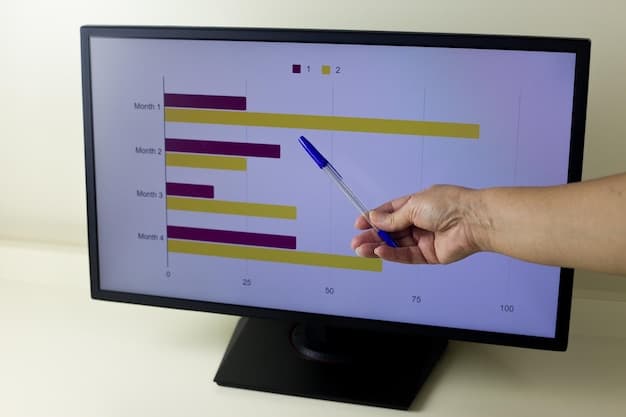E-commerce A/B Testing: Boost Your Digital Marketing

E-commerce A/B testing is a method of comparing two versions of a webpage, app screen, or other digital asset against each other to determine which one performs better, ultimately enhancing your digital marketing strategy with data-driven insights.
Want to improve your e-commerce digital marketing using data? E-commerce A/B testing is your key to making informed decisions and maximizing conversions. Use A/B testing to optimize your website and turn visitors into buyers.
What is E-commerce A/B Testing?
E-commerce A/B testing, at its core, is a scientific approach to improving your online business. It’s about making decisions based on data, not gut feelings.
By systematically testing different versions of your website, you can identify the changes that have the most positive impact on your key performance indicators (KPIs).
The Basic Principle
The fundamental principle of A/B testing is straightforward: divide your audience into two or more groups and show each group a different version of a webpage, email, or other digital asset.
You then measure how each group responds and determine which version performs better. This involves setting up a hypothesis, defining your metrics, and statistically analyzing the results to determine a winner.
- Hypothesis Creation: Forming a testable statement about what changes will improve a specific metric.
- Traffic Division: Splitting your website traffic randomly between the control (original version) and variation (the modified version).
- Statistical Analysis: Using statistical methods to determine if the observed differences between the versions are significant or due to random chance.
E-commerce A/B testing identifies changes with positive impact on key performance indicators using a divide-measure-analyze method.

Key Elements to A/B Test in E-commerce
Many elements on your e-commerce site can be A/B tested. Concentrate on elements with potential impact on conversion rates and user experience.
Prioritization ensures your effort yields the best results. Testing should focus on elements pivotal to the customer journey.
Call-to-Action Buttons
A/B test your call-to-action (CTA) buttons, experimenting with different colors, text, and placement. A simple change in the color or wording can significantly impact click-through rates.
For example, testing “Add to Cart” versus “Buy Now” or changing the color of the button from blue to green can influence user behavior. Analyze which button drives more conversions.
Product Descriptions
Vary your product descriptions to see which resonates best with your target audience. Try different lengths, tones, and styles to find the most compelling language.
Test whether customers respond better to detailed, technical descriptions or to shorter, benefit-oriented summaries. Also test the impact of incorporating storytelling elements.
- Images and Videos: Experiment with different visuals to see which ones attract the most attention and drive the most engagement.
- Headlines and Subheadings: Try various headlines to see which ones capture your audience’s attention and convince them to explore further.
- Layout and Design: Experiment with different layouts to see which ones are the most user-friendly and intuitive.
Testing key webpage elements maximizes conversions and improves user experience, contributing to business goals.
How to Set Up an A/B Test
Setting up an effective A/B test involves planning, execution, and analysis.
Careful setup ensures accurate results and actionable insights. A structured approach minimizes risks and maximizes learning.
Define Your Goals
Before you start testing, identify what you want to achieve. Are you trying to increase sales, improve user engagement, or reduce bounce rates?
Clearly define your goals to ensure your tests are focused and relevant. Specific goals allow you to measure success accurately and make informed decisions based on the results.
Choose the Right Tools
Select an A/B testing tool that fits your needs and budget. Numerous options are available, ranging from free plugins to enterprise-level platforms.
Popular tools include Google Optimize, Optimizely, and VWO. Each offers different features and capabilities, so choose one that aligns with your expertise and your website’s architecture.
Analyzing the Results
Once your test is complete, analyze the results. Determine whether the changes led to a statistically significant improvement in your chosen metrics.
Consider using statistical significance calculators to validate your results. If the changes did not yield a significant improvement, consider testing alternative changes.
An accurately planned, executed, and analyzed A/B test delivers actionable insights and statistically significant improvements.
| Key Point | Brief Description |
|---|---|
| 📊 Define Goals | Identify specific, measurable goals before testing. |
| 🎨 Test Elements | A/B test CTAs, descriptions, and layouts for impact. |
| 📈 Analyze Results | Assess statistical significance for data-driven decisions. |
| 🚀 Implement Wins | Deploy winning variations for continuous optimization. |
FAQ
▼
The ideal duration depends on your website’s traffic and conversion rates. Generally, run the test until you reach statistical significance, which can take a few days to several weeks.
▼
Start with testing only one element at a time. Testing multiple elements can create confusion and make it difficult to determine which changes are responsible for the results.
▼
Yes, but it might take longer to achieve statistically significant results. Consider using multivariate testing or making larger changes to see quicker impacts.
▼
Indirectly, yes. By improving user engagement and conversion rates, A/B testing can lead to increased search engine rankings due to better user experience metrics.
▼
Common mistakes include stopping tests too early, testing too many elements at once, not having a clear hypothesis, and ignoring statistical significance.
Conclusion
E-commerce A/B testing provides a data-driven approach to optimizing your digital marketing efforts. By continuously testing and refining your website, you can significantly improve user experience and drive conversions. Embrace this process to gain a competitive edge and achieve sustainable growth in the dynamic world of e-commerce.





